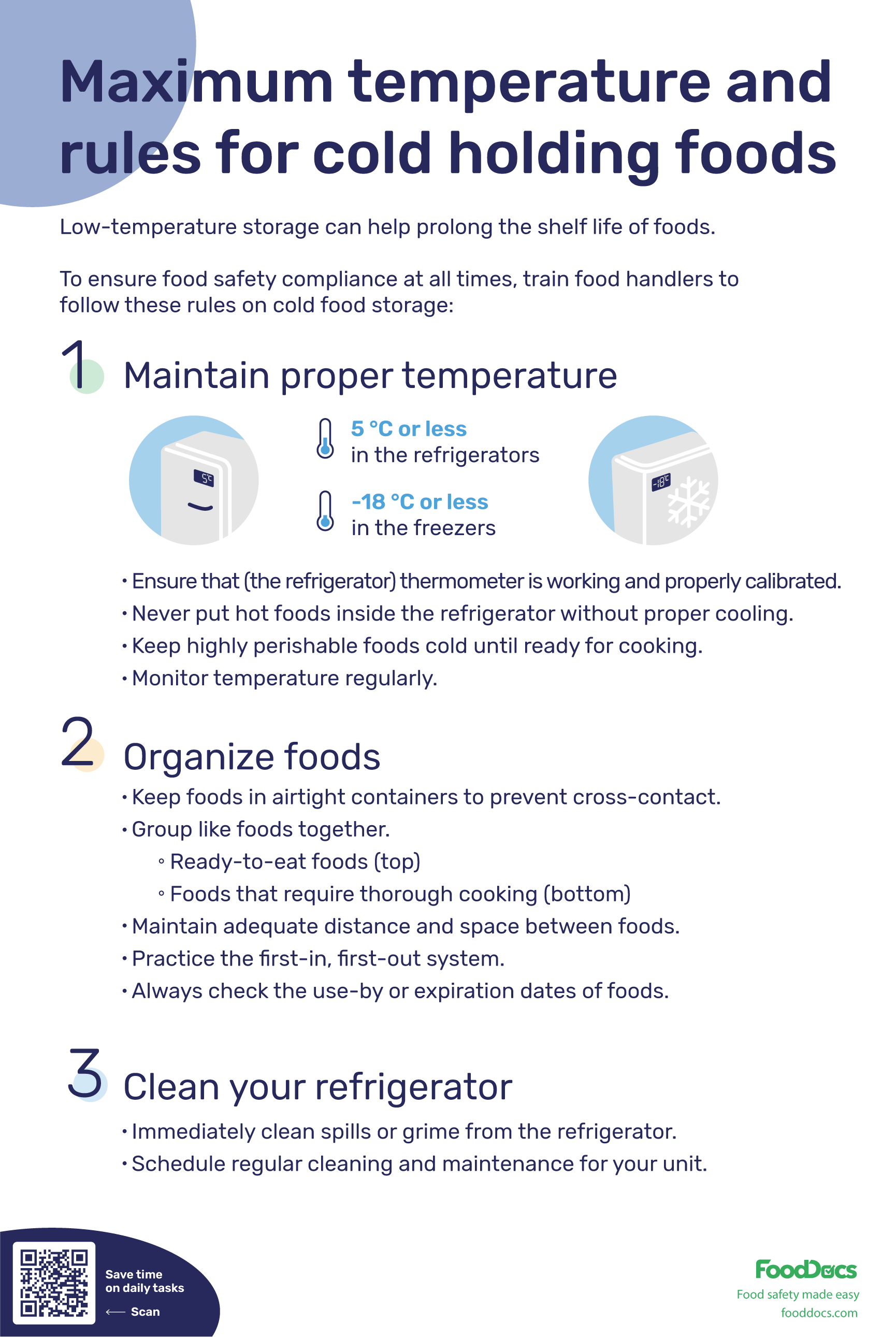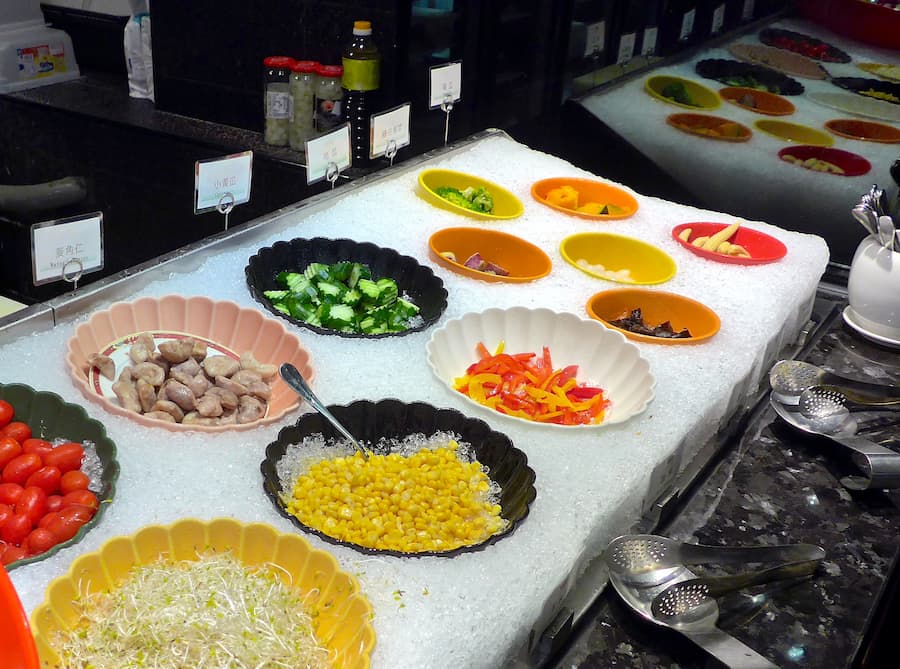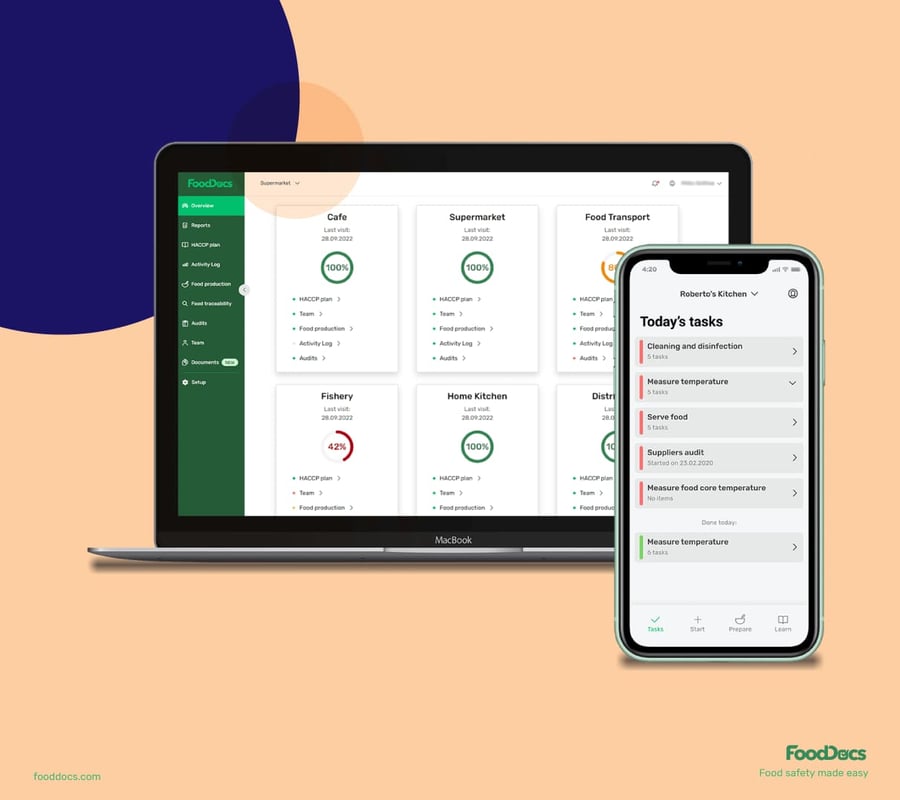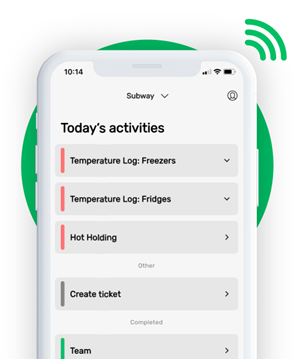COLD HOLDING FOODS POSTER


This is how our Digital Food Safety platform saves 20% of your time on daily tasks:
- Get upcoming task notifications
- Add data into the app
- Check the status of tasks in real-time

When food safety was still handled on paper, I typically spent a couple of hours per day getting the papers and going around checking or completing tasks… Now I can sit down and it's just all there in one place. It takes me 5-10 minutes.
Ruth B.
Store Manager
What are the rules for storing cold food?
Cold storage plays a great role in the food supply chain. This aspect of food safety makes distribution and safe storage possible for food businesses. It allows food to stay fresh and safe for consumption significantly more than when foods are stored at ambient food temperature. What is usually fresh for only weeks may stay fresh for 1-2 months under cold storage. Food handlers must be thoroughly acquainted with what are the rules for storing cold food in addition to the proper cooling method itself.
The benefits of cold storage in the food industry are invaluable to the success of an establishment. It allows food businesses to store fresh foods and give them more variety while maintaining safety. The application of cold storage can span from safety to quality assurance as well and can prevent food waste on a large scale. Cold or frozen foods are more likely to retain their fresh and peak qualities.
Find out how storing cold food works, why you need it, and how can you ensure that the conditions are met at all times through this article.
What is cold food storage?
Cold storage refers to the operation of storing foods under low temperatures to slow down the growth of any foodborne pathogens. Cold storage facilities help food businesses prolong the shelf life of foods that are sensitive to temperature.
Time and temperature control for safety foods or TCS foods are considered highly perishable and often require cold food storage. The type of food item under this category include fresh poultry products, dairy products, ground meat, fresh fish, and leafy greens. This term is applicable to both refrigeration and freezing.
The main principle behind cold food storage and the ideal freezer temperature is to slow down any biological process around the food, including that of spoilage bacteria. These processes include those of the potentially present pathogens and the food itself.
Why do you need to store the food at the correct temperature?
Storing food at the correct refrigerator temperature, in this case, cold storage ensures that the food will stay safe from contamination and will not cause food poisoning to consumers. It is an essential, basic food safety practice.
At low temperatures, most pathogenic organisms, including harmful bacteria, molds, yeasts, and viruses, are slower to reproduce. As such, they are less likely to spread and spoil the foods and are easier to eliminate from cooking. Refrigerated items have a longer shelf life.
In addition to slowing down the growth of bacteria, cold food storage areas also slows down the reaction rate of enzymes and deterioration of food quality. With low temperatures, foods such as fresh fruits and vegetables are less likely to brown and oxidize, making food unappetizing. Through cold storage, food businesses can serve safe and great quality foods.
Why do you need to hold perishable foods at the correct temperature?
Perishable foods are more prone to food spoilage than shelf-stable products or non-TCS food. Spoilage can occur as a result of food contamination and uncontrolled pathogenic microorganism growth in foods. At a certain temperature range, pathogens can grow fast and digest the food, producing unwanted by-products such as organic acids and toxins from toxigenic microorganisms. This temperature range is often referred to as the food temperature danger zone and is an imminent health hazard.
Perishable foods are rich in nutrients and high in moisture. These intrinsic factors provide a great growing environment for bacteria. This type of food is also called high-risk TCS food or time/ temperature control for safety food. Cold-holding perishable foods at a safe temperature can delay food spoilage and protect consumers from foodborne diseases. In some food establishments, such as commercial kitchens, this operation is considered a critical food safety practice with a corresponding critical limit. A good example of this is establishments that serve food in salad bars or retail food stores that display food on ice.

Low temperature slows down the growth of bacteria and prevents them from causing significant changes in the food. In addition, this safe food temperature is also effective in slowing down the deterioration of the food's quality from an enzymatic reaction, such as browning and wilting.
The best way to achieve the maximum effects of cold-holding foods is to consistently maintain the correct temperature range and monitor it with a digital food thermometer. Temperature control for safety is possible with a working cold-holding unit, a properly calibrated appliance or kitchen thermometer, and a fridge temperature monitoring log.
What will happen if you do not store food at a proper temperature
Storing perishable foods at the temperature danger zone within the two to four-hour time limit can result in spoilage and food waste. These effects can lead to foodborne illness from bacteria. Depending on the temperature of the surrounding, the rate of food spoilage can occur faster. In general, the hotter the environment is, the faster the food will spoil.
Spoiled foods can cause problems when consumed, such as food poisoning. Some signs of food spoilage include the following:
- Sour taste in foods or increase in acidity
- Off-putting smell
- Change in texture
- Discoloration
- Growth of bacterial colony or cottony mold
- Slime formation in food
Some effects of pathogens may not be visible to the human eye, such as the production of toxins, but nevertheless makes food unsafe for consumption.
Ambient temperature or hot conditions provides these pathogens with good growing conditions on food items. Food without temperature control is considered a risk in any food establishment. Every food business operator must be aware of how to handle cold-holding prepared foods.
Similar results from unwanted bacterial growth can occur when food in cold holding is not properly maintained. Circumstances such as refrigerating hot foods can increase the temperature in the refrigerator. If the temperature of food falls into the temp danger zone for more than 2 hours, even if they are inside the refrigerator, harmful bacteria and other pathogenic microorganisms in food products can still cause spoilage.
Who needs a Maximum Temperature for Cold Holding Foods poster?
Food service establishments such as restaurants, cafeterias, and institutional food services, including retail food stores, will benefit from a Maximum Temperature for Cold Holding Foods poster. These food businesses often deal with cold-holding high-risk food products.
The poster can help food handlers remember the most important food safety rules when it comes to refrigerating perishable foods. This can help ensure that all foods served in your food business will not cause foodborne illness. It also includes other essential rules for cold-holding foods to eliminate the risk of cross-contamination and food spoilage.
Download and use our free Maximum Temperature for Cold Holding Foods poster by attaching it to your cooling units, where it is visible to food employees.
Find more useful templates, checklists, and posters from our free HACCP plan template hub.
Tips for cold-holding food
As a general rule, food workers must keep cold food cold consistently at the correct holding temp to prevent food spoilage and protect customers from harmful foods with food safety risks. In addition to this rule, there are other essential approaches to food safety that need to be considered.
Here are a few tips that you can consider as food safety guidelines when keeping perishable food cold:
- Maintain the proper temperature in refrigerators at 5 °C or below.
- Keep frozen foods at -18 °C freezer temperatures.
- Ensure that the appliance thermometer of your cooling unit is regularly maintained and calibrated.
- Do not put hot batches of food inside the refrigerator. Use the two-stage cooling method to cool foods.
- Regularly monitor temperatures.
- Throw harmful food for consumption that is exposed to the temperature danger zone for over the 4-hour limit.
- Keep foods in airtight food containers or packaging to prevent cross-contamination and germ growth.
- Group like foods together inside the refrigerator. Place ready-to-eat foods at the topmost shelf and raw food ingredient (e.g., raw meat products and poultry) at the bottom.
- Maintain adequate distance and space between foods. This will help improve air circulation in the cooling unit.
- Practice the first-in, first-out system.
- Always check the use-by or expiration dates of store-bought products on the product label.
- Immediately clean spills or food residue from the refrigerator food contact surface.
- Schedule regular cleaning and maintenance for your unit.
- Train food service operators on how to maintain a cooling unit.
These tips for food safety and rules are conveniently listed and presented in a readable manner in our Maximum Temperature and Rules for Cold Holding Foods chart. Use this chart to remind all team members regarding the essential food safety requirements in maintaining the proper temperature.
You can also use our Proper Food Storage chart as a guide for the maximum time foods can remain in cold storage.
How can I help my team in storing cold food properly?
Storing cold food properly requires constant monitoring of food safety temperatures to become effective. The more frequently you monitor this condition, the more effective it can be. Non-compliance with safe temperatures, such as temperature fluctuations or temperature abuse, can be easily detected when food facility operators monitor the cooling units regularly. The sooner problems are detected, the faster you will be able to apply corrective actions.
The problem is that you cannot expect food handlers to focus on this single task all the time. Our Maximum Temperature and Rules for Cold Holding Foods chart can help food employees remember the proper food safety regulations for this operation, but it cannot help your team remember when to monitor the temperature.
At FoodDocs, we offer an intuitive solution that can cover this area of your operations and more. Using our digital monitoring solution, you can get the following benefits:
- Digital app is equipped with a smart notification system. This feature will alert employees and remind them when it is time to monitor the appliance temperature. With this feature, you can ensure that all food safety tasks are done on time and correctly.
- Monitoring app is equipped with an auto-fill solution for monitoring logs. You can use this feature to help your team save time on monitoring cold-holding temperatures. All that they need to do is verify the logged information.
Digital solution to help food managers save time
Building a digital Food Safety Monitoring System has never been as easy as how we do it in FoodDocs. Our system can help you create a comprehensive monitoring system with the help of artificial intelligence and a machine learning program.

FoodDocs Digital Monitoring System
With our digital solution, managers can get the following benefits:
- Switch to a digital platform in just 15 minutes. Our system can generate all necessary digital monitoring forms as you answer basic questions about your operations.
- Our digital solution is fully integrable with IoT sensors. Connect your smart cooling units with our system and allow the data to be automatically recorded. With this feature, monitoring data is reflected in real-time and save time on supervision.
- Get a cloud-based storage system where you can store all digital information and access them at any time.
Build a more sustainable food safety system and become more efficient in maintaining compliance with our digital Food Safety Management System.
With this digital solution, you can continuously improve your monitoring operations, as all automatically generated monitoring logs are customizable. Create a system that is tailor-fit to your operations effortlessly.
Maintain compliance with food safety standards with the help of our digital solution. Experience all of these benefits by using our free 14-day trial.
Frequently Asked Questions
Do you have some more questions regarding cold-holding, potentially hazardous foods? Here are a few frequently asked questions and the most relevant answers to this topic.
What temperature should cold food be received, stored, and held at?
Ideally, high-risk foods must be received, stored, and held at temperatures ranging between 0 °C to 5 °C. This temperature range is ideal for maintaining the freshness and safety of potentially hazardous foods until they are served.
What is the maximum time for storing high-risk cold food above 5 C?
Foods stored at 5 °C with periodical monitoring can remain safe for up to 3 days. Beyond this point, safety and quality must be assessed before using the materials. Foods can stay fresh and safe for longer times when stored at 0 °C and below, but this temperature range can free the foods and affect quality.
Can food be held between 41 and 135 degrees?
High-risk foods are not recommended to be held between 5°C to 57 °C for longer than four hours. This temperature range is referred to as the food temperature danger zone. At most, foods can stay within this temperature for 2 to 4 hours. Beyond this time, foods must be disposed of as the risk of food spoilage and causing foodborne illnesses is higher.














